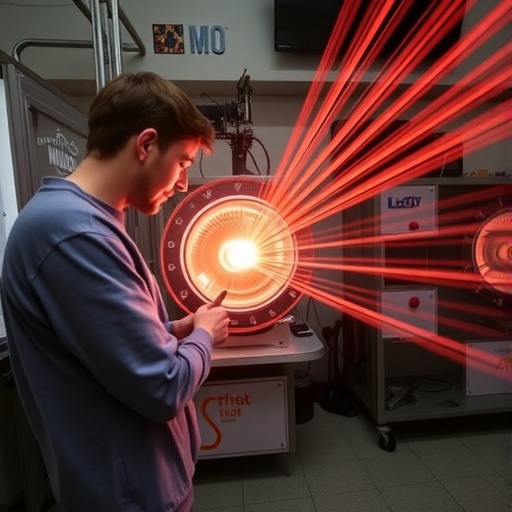At the University of Missouri, a groundbreaking experiment has unveiled new insights into the behavior of molecules under extreme conditions, akin to the environment found in outer space. Led by renowned chemist Arthur Suits and his doctoral student Yanan Liu, the research team has successfully generated, manipulated, and detected molecular vibrations at unprecedented temperatures. By firing laser pulses at methane gas molecules traveling faster than the speed of sound in a vacuum chamber chilled to nearly absolute zero, this pioneering work opens up new frontiers in astrochemistry and our understanding of the universe.
The conditions created in the laboratory mimic the frigid, almost completely devoid of matter environments that exist in the vastness between stars. Researchers utilized a supersonic flow, produced by emitting molecules through a rocket nozzle, to study how these high-velocity particles behave when subjected to laser light. In essence, the pulsed laser excites the methane molecules, causing them to vibrate and create sound waves, which were detected using ultra-sensitive microphones.
This innovative approach—termed photoacoustic spectroscopy—has long been deemed impractical in extreme settings due to the inherent challenges associated with transmitting sound in a vacuum. In general, sound requires a medium, such as air or water, to propagate. The concept that sound might still emerge from airborne particles moving at supersonic speeds has confounded previous researchers. Yet, the Missouri team was able to capture the phenomenon of sound emerging as these excited molecules impact the sensors.
Suits is adamant about the broader implications of this research. By refining our understanding of molecular rotations and vibrations at such low temperatures, the team aims to enhance knowledge about the chemical reactions that govern the formation of stars, planets, and potentially even life’s origins. The results of the study aim to lay the groundwork for future explorations into astrochemistry, which explores the interactions and transformations of the elements that exist throughout the cosmos.
The implications of this work extend beyond just the realm of theoretical chemistry. Insights derived from this research could benefit various fields, including the aviation, manufacturing, and energy sectors. Understanding the chemical dynamics occurring in interstellar conditions could enable scientists to model and predict new chemical reactions under laboratory conditions that simulate the exotic environments found throughout the universe.
Methodologically, the success of this research underscores the importance of inter-disciplinary collaboration within the realms of physics and chemistry. By leveraging sophisticated technology and innovative experimental techniques, Suits and Liu were able to achieve results previously thought impossible. The work has garnered funding from prestigious organizations, including the U.S. Department of Defense and the National Science Foundation, highlighting its potential significance in addressing complex scientific questions.
As part of this ground-breaking study titled “Photoacoustic Spectroscopy in a Supersonic Flow,” published in the Journal of Physical Chemistry A, the authors provide detailed insights and underlying mechanisms that elucidate how sound can materialize from supercooled, high-speed molecules. This research not only provides fundamental insights into molecular behavior but also serves as a springboard for additional investigations into other gaseous compounds beyond methane.
One of the most promising aspects of this research is its potential to unravel the mysteries of the cosmos. The ability to detect otherwise elusive chemical reactions at such low temperatures could lead to advancements in the study of interstellar chemistry. By closely monitoring how various molecules react and interact under conditions similar to those in space, scientists may uncover critical information about the building blocks of life and the processes that govern the universe.
Researchers are optimistic that the techniques developed at Mizzou can be applied to a wide variety of chemical systems, moving beyond methane to include other compounds that may have similar dynamics in extreme environments. As the study progresses, there may be opportunities to test and refine these detection methods in hopes of gathering data that could one day bolster our understanding of the origins of life and the universe itself.
Overall, this research represents more than just a technical achievement; it serves as a reminder of the power of human ingenuity and collaboration in overcoming obstacles previously thought insurmountable. By deepening our understanding of molecules at extreme conditions, this team is contributing not just to theoretical knowledge, but to practical applications that could reshape our understanding of chemistry and its role in the cosmos.
The journey to harness the power of laser technology in understanding molecular behaviors illuminates the intersections of science, innovation, and exploration. Scientists like Arthur Suits stand at the forefront of knowledge, searching for answers to some of the universe’s most profound questions. As we venture deeper into the realm of astrochemistry, we may be closer than ever to revealing the secrets of the stars and the molecular underpinnings of life itself.
The future of this research promises exciting developments, not only in our grasp of chemistry under extreme conditions but in expanding the boundaries of scientific inquiry. The findings signal a new chapter for researchers eager to uncover what lies beyond our planet, utilizing advanced technologies to illuminate the darkness of space.
Suits’ pioneering work serves as an inspiration for future generations of scientists, as it encapsulates the relentless pursuit of knowledge and the quest to understand our place within the vast expanse of the cosmos continues.
Subject of Research: Molecules in extreme cold and vacuum conditions
Article Title: Photoacoustic Spectroscopy in a Supersonic Flow
News Publication Date: 15-Jun-2025
Web References: Journal of Physical Chemistry A
References: DOI: 10.1021/acs.jpca.5c02265
Image Credits: Credit: University of Missouri
Keywords
Chemistry, Astrochemistry, Photoacoustic Spectroscopy, Molecule Detection, High-Speed Chemistry, Extreme Conditions, Sound Waves, Laser Technology, Interstellar Chemistry, Molecular Vibrations, Advanced Research, Scientific Innovation.




